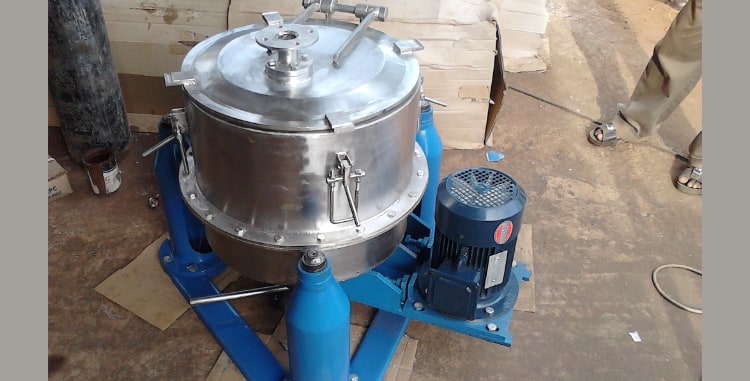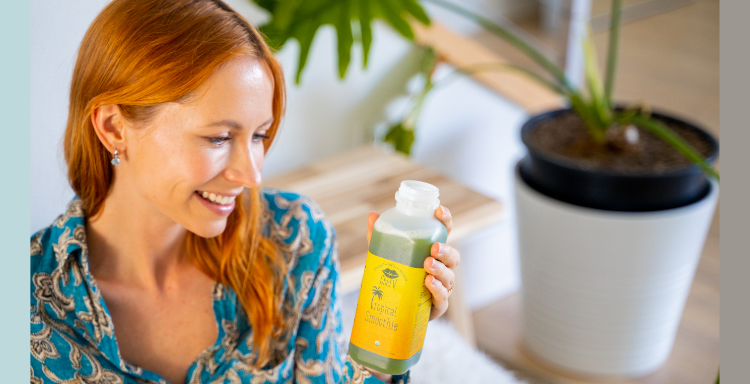Time is of the essence. A perfect looking piece of green kale—one of the 7 leafy greens in Organic Green Drink—has just been plucked from the ground. As soon as produce leaves the mineral-rich cozy confines of healthy soil, it starts losing nutritional value.
In this article, Chef V explains the optimal shelf life of juices made from dark, leafy greens—and the most nutritious method to make green drinks. Think your store-bought juice is healthy? You may be in for a surprise!

above, commercial centrifugal juicer
Centrifugal Juicers
Centrifugal juicers extract juice at super fast speeds. Where’s the harm in that? After all, if you have thousands of customers, you need fast production. The problem with warp-speed juicing is that the high velocity of the juicer creates a tremendous amount of heat in the juicing blades.
When it comes to cooking oils and produce, there’s no greater nutritional killer than heat. The heat generated in the metal blades of conventional centrifugal juicers destroys some of the enzymes in the oranges (and green leafy veggies, in the case of mega corporation green juices).
Another problem with juicing produce is that the high heat causes oxidation. Oxidation is the chemical reaction that turns a partially-eaten apple that’s left out into a brown, unappetizing, rancid-looking piece of rubbish.

Cold-Blended Green Drinks
When I decided to take the plunge as an entrepreneur over a decade ago, I was committed to providing the most nutritious green drink available. And what I discovered was there was indeed a healthier way to turn a bunch of the healthiest dark, leafy green veggies into a juice—without losing any of the nutritional value.
You don’t have to have a degree in chemistry to figure out that cold-blending is a technique that involves no heat. Therefore, all the enzymes, nutrients and phytochemicals in the leafy greens are preserved. Cold-blended juice is basically as close as you can possibly get to having a salad with the same leafy greens.
Yes, speed is sacrificed with the cold-blended process. But my motto with Chef V isn’t “Over 1 billion Green Drinks served.” I may not be able to whip up a juice at 10,000 revolutions per minute like a conventional chain juice bar. But taking only a few seconds to achieve salad-level nutritional quality will most likely never be a reality, at least not in my lifetime.
Thankfully, however, juicing technology has come a long way. Here at Chef V headquarters, we have some of the biggest and most powerful industrial juicers available. The powerful technology of modern blenders allows us to make your Green Drink fresh—without any nutrient-zapping heat!
Raw Vs Pasteurized Juice
The other raging debate in the world of juicing involves unpasteurized (raw) versus pasteurized juice. Now don’t get me wrong. I think Louis Pasteur was a genius for the invention of his eponymously-named method to rid food of harmful bacteria. But pasteurization was introduced in 1863—long before modern refrigeration greatly eliminated the threat of becoming ill because of food-borne microbes.
Juice sold in supermarkets has to be pasteurized by law. But pasteurization kills the beneficial bacteria in the dark, leafy greens. When you purchase veggies from a supermarket, they are not pasteurized. So why would you want to consume pasteurized kale, chard, collard greens, lettuce, parsley, and dandelion greens?
The pasteurization process also denatures some of the natural enzymes. But hey, if you like your bottle of juice to be able to sit in your fridge for several weeks, go ahead and purchase pasteurized juice.
Some juice brands proudly claim that they use flash-pasteurization. This is an ultra-fast method of killing microbes. But the truth is that all types of pasteurization involve nutrient-killing heat. Yes, there is also something called cold pasteurization, but I don’t know any juice companies that use this method. But according to this research article, even cold pasteurization leads to the inactivation of enzymes in the food and extends the shelf life.
How Long Should Green Drink Last?
How natural does it seem to you that a bottle of juice can stay preserved for weeks? Do you think that’s how Mother Nature intended us to eat? Sure, refrigeration is a modern convenience, a miracle really. But no nutrient-dense green juice should be viable for weeks.
Cold-blended ORGANIC GREEN DRINK stays fresh for up to 7 days. You can think of CHEF V GREEN DRINKS as direct to consumer. When you buy brand-name juice, you’re most likely consuming a high-sugar, nutritionally-dead food. (Well, if not totally dead, then nutritionally in a coma.)
Pure and Clean Ingredients
With CHEF V ORGANIC GREEN DRINK, there are no preservatives, fillers or GMO ingredients. It was my mission when I launched my company—and will always be—to provide the seven leafy greens as close to their nutritional value that Mother Nature provides.
What’s in your juice?
To your health,
Chef V


